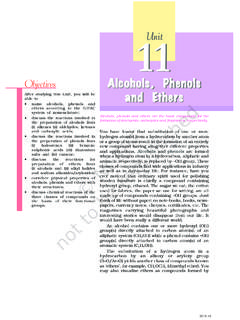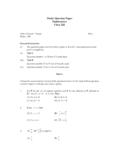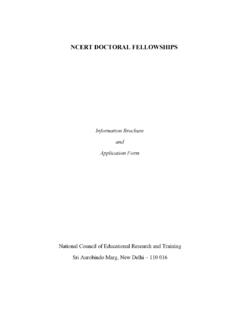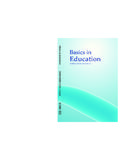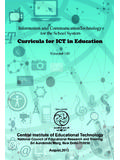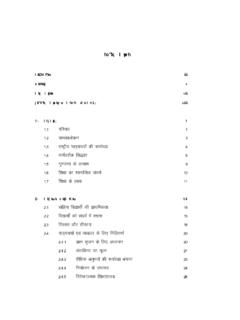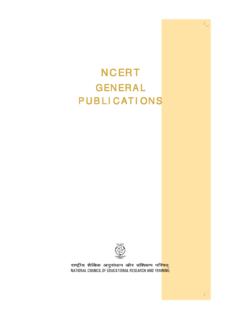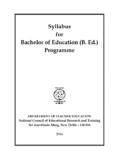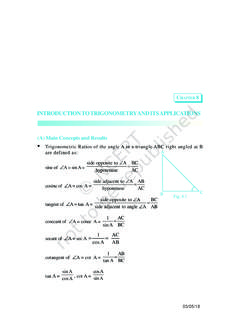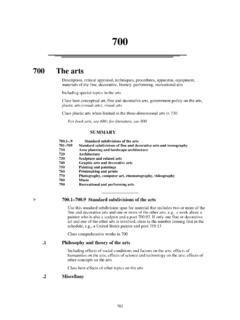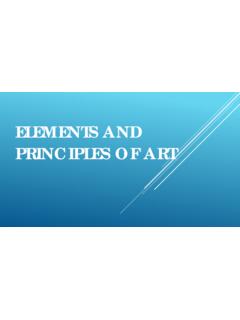Transcription of AN INTRODUCTION TO INDIAN ART - NCERT
1 AN INTRODUCTION TOINDIAN ARTT extbook in Fine Artsfor Class XIPART I2021-22 First EditionSeptember 2012 Asvina 1934 ReprintedAugust 2015 Shravana 1937 February 2018, Magha 1939 April 2019, Chaitra 1941 August 2019 Shravana 1941 April 2021, Chaitra 1943PD 35T RSP National Council of EducationalResearch and Training, 2012` on 80 GSM paper with NCERT watermarkPublished at the Publication Division bythe Secretary, National Council ofEducational Research and Training, SriAurobindo Marg, New Delhi 110 016and printed at Nikhil Offset, 223, 127,DSIDC Complex, Okhla Industrial Area,Phase-I, New Delhi-110020 ALL RIGHTS RESERVEDqNo part of this publication may be reproduced, stored in aretrieval system or transmitted, in any form or by any means,electronic, mechanical, photocopying, recording or otherwisewithout the prior permission of the book is sold subject to the condition that it shall not, by wayof trade, be lent, re-sold, hired out or otherwise disposed ofwithout the publisher s consent, in any form of binding or coverother than that in which it is correct price of this publication is the price printed on thispage.
2 Any revised price indicated by a rubber stamp or by asticker or by any other means is incorrect and should TeamHead, Publication:Anup Kumar RajputDivisionChief Editor:Shveta UppalChief Production Officer:Arun ChitkaraChief Business:Vipin DewanManager (In charge)Editorial Assistant:Mathew JohnProduction Assistant:Om PrakashCoverSurender KumarLayoutSeema SrivastavaOFFICES OF THE PUBLICATIONDIVISION, NCERTNCERT CampusSri Aurobindo MargNew Delhi 110 016 Phone : 011-26562708108, 100 Feet RoadHosdakere Halli ExtensionBanashankari III StageBangaluru 560 085 Phone : 080-26725740 Navjivan Trust 380 014 Phone : 079-27541446 CWC CampusOpp.
3 Dhankal Bus StopPanihatiKolkata 700 114 Phone : 033-25530454 CWC ComplexMaligaonGuwahati 781 021 Phone : 0361-267486911144 AN INTRODUCTION TO INDIAN ARTT extbook for Class XIISBN- 978-93-5007-187-82021-22 FOREWORDThe National Council of Educational Research and Training( NCERT ) has constantly been working for the past fiftyyears to bring in an impact on the country s schooleducational system. In the recent years, specially with theNational Curriculum Framework (NCF) - 2005, there has beena significant shift in the development of textbooks, theirpresentation and inter-disciplinary approach, the typologyof exercises, etc.
4 All these efforts have made the textbookschild friendly. At the senior secondary stage, which is alsothe school leaving stage, students should have more optionsto move further in different fields of higher education orprofessional education. With this view, the NCERT for thefirst time took the initiatives of developing the curriculumand syllabi in different art related areas for this this stage of education, the emphasis has been givento a professional approach towards the subject of Fine Artsmaking it a discipline rather than on creating awarenessand knowledge, which was generic in nature till secondaryclasses.
5 The teaching objectives also shift towardssharpening of skills in fine arts and develop a perspectiveof design and instead of free expression and doing artsemphasis is on students expressing themselves in theirown style and medium. Also, there has been a need todevelop a historical perspective of art in context of theworld as well as India. Art History is a part of studies ofarts and in itself it is a major area of education from whichstudents learn about their cultural was observed that many of the education boards offerFine Arts as an optional subject at the senior secondarystage which includes painting, sculpture , applied arts orcommercial arts.
6 These were reviewed and a new syllabuswas formed. Since this course apart from the practicalcomponent include theory which introduces students tothe art historical heritage of country s diverse art andarchitecture, the textbook An INTRODUCTION to INDIAN Art has been developed for Classes XI and textbook for Class XI extensively covers the traditionof cave paintings in the pre-historic era and theircontinuation in mural paintings of Buddhist era and later2021-22on in various parts of the country, Buddhist, Jain andHindu sculptural and architectural developments. Duringthe Indo-Islamic period and before the Mughal rule,another era dawned upon India, which saw massiveconstructions in the form of forts and palaces.
7 Differentaspects of all these styles have been discussed to introducestudents with the fabric of India s NCERT appreciates the hard work done by theTextbook Development Committee responsible for makingthis book. We wish to thank the Chief Advisor for thistextbook, Professor Ratan Parimoo, Retired Head,Department of Art History and Dean, Faculty of Fine Arts,M. S. University of Baroda, for guiding the work of thiscommittee. It was a challenge for other art historiansinvolved in making of this textbook for students at theschool level and their efforts are praiseworthy. We areindebted to the institutions and organisations which havegenerously permitted us to draw upon their resourcematerials and personnel.
8 We are especially grateful to themembers of the National Monitoring Committee, appointedby the Department of Secondary and Higher Education,Ministry of Human Resource Development under theChairpersonship of Professor Mrinal Miri and Deshpande, for their valuable time and an organisation committed to the systemic reform andcontinuous improvement in the quality of its products, NCERT welcomes comments and suggestions which willenable us to undertake further revision and refinement. DirectorNew DelhiNational Council of EducationalSeptember 2012 Research and Trainingiv2021-22 PREFACED uring the nineteenth century (the period of British rule),a few British colonial officers took active interest to studyIndia s past in collaboration with some INDIAN scholars andit is out of such endeavours that a systematic study ofarchitectural monuments, sculptures and paintings beganin the INDIAN sub-continent.
9 The first attempt in this regardwas to document the monuments as they represented avery visible evidence of the bygone era. Over a period oftime with the archaeological explorations and excavations,many art-historical sites were discovered. Deciphermentof inscriptions and study of coins played a significantrole in our understanding of the past art traditions. Withthe study of religious texts, history of religion was studiedand identification of icons/sculptures and paintings wasinitiated, which became a dominant area of earlyscholarship. Study of art history has developed inassociation with the archaeological studies, however, it isnow recognised as a specialised discipline.
10 In the West,mainly in Europe, the art-historical discipline has grownconsiderably with numerous methodological inputs,whereas in India it is still in the process of developing itsinvestigating the study of art history has grown out of extensivedocumentations and excavations, one finds description ofart objects as a prominent method of study. There are afew significant studies of the early twentieth century, wherethe concerns are addressed beyond mere , several generations of outstanding Westernand INDIAN scholars of INDIAN art history have studied thesubject at great depth making us realise the glorious pastof the INDIAN civilisation through its creations reflected inthe architectural monuments, sculptures and can claim a distinct INDIAN approach to the arts of thebuilding edifices, the sculpture making and the languageof painting in comparison with the European art on onehand and the far Eastern art on the other.
